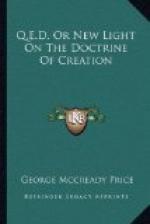We look at ourselves and we feel sure that we have a separate and real existence, that we are rationally conscious and are endowed with choice and free will. We can say almost as much for an intelligent bird or dog. But we hesitate to say how many of these powers or characteristics of free and independent personality can be assigned to the unicellular organisms, such as the amoeba or the corpuscles of our blood. These one-celled creatures are also alive, are just as truly alive as are those composed of many cells. Even the corpuscles of which our bodies are composed move, and eat, and grow, and seem really endowed with intelligence like the higher forms of life. Suppose we could go further than is now possible and could lay bare the ultimate make-up of the chromatin of these one-celled creatures, would we even then be able to prove that life with all its properties is inherent in these material components of the cells? In other words, would we really solve anything after all? Or would we not rather be compelled to acknowledge that the simplest, the most truly rational view of the question is that in living matter we have merely a special manifestation of the presence and the direct action of the God of nature which we cannot so readily recognize in not-living matter? This, it seems to me, is all that we really know, and all that we are likely ever to know.
When we examine carefully the differences between the living and the not-living, we see that the chief difference between them is in their origin. The matter of growth is not a real distinction; for crystals grow on the outside, while inorganic liquids grow by intussusception, as when a soluble substance is added to them, in very much the same way as an animal grows by the ingestion of food. Even movement is hardly an absolute distinction between the living and the not-living; for no movement can be detected in quiescent seeds, which may lie dormant for thousands of years; and on the other hand inorganic foams when brought into contact with liquids of different composition display movements that very closely simulate those of the living matter. Lastly, irritability, though so notably characteristic of living matter, is scarcely peculiar to it, for many inorganic substances seem almost as definitely responsive to external stimulation. But in the matter of their origin there is a real and a most fundamental difference. All living substance arises only from other substance already living. It cannot arise from the not-living; or at least it never has done so since the beginning of scientific observation, though on this point have been concentrated the learning and the laboratory technique of thousands of chemists and microscopists.




